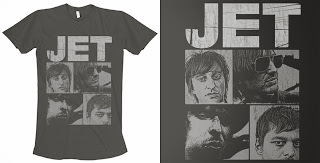Brandon Rike
Brandon Rike
is a full time graphic designer and Rocker by night. This young guy has
designed his album covers, merchandise, logos and T-shirts for his Bands Dead
Poetic and At Night We Strike. Besides being a modern designer, he is a techy
who has a blog and tweeter feed for his fans to follow. Brian was asked what
was his biggest challenge running a design business and this was his response:
Today Kare rather work on
designing than representing the business. She is intrigued with the possibility
of improving the quality of small monochrome and typefaces in fast handheld
devices.
The biggest
problem that I have running my freelance operation is maintaining a balance
with my social life, and happiness level in general. We assume, early on, that
if we work hard enough, we can achieve a certain level of success. It is also
our assumption that that level of success will bring us a wealth of happiness.
It doesn’t. Achievement of our goals only prompts us to set a new goal, instead
of taking any time to enjoy reaching a milestone. After doing freelance design
for over a decade, I have set goals and achieved them – only to set a higher
goal for the following year, and thus put myself right back to the grind –
glossing over any chance to pat myself on the back. It’s possible that
continued success in a creative field has an adverse reaction to one’s
happiness. Being creative all day, every day, gets more and more taxing. The
well of ideas threatens to dry up, and we put more and more pressure on
ourselves to stay afloat. The quest for “better” is admirable, but also
tortuous. This grind keeps me in my cave, churning out work, giving myself
little to no interaction with the outside world. More success, for me, has led
to a very reclusive lifestyle. On paper, I’m experiencing the most successful
time of my life – in reality, I can’t remember the last time I sat down with a
friend for coffee. The solution? Move
happiness to first on your priority list. Meeting with people you enjoy or
doing things you love can put you in a positive frame of mind that’s more
equipped with managing a heavy workload. This positive outlook instantly
manages stress better, and is more effective at calculating an otherwise
chaotic and overwhelming to-do list. Days may look less like a row of fires to
put out, and more like the privilege that we began these careers with – that,
while others toil through jobs that they hate, we get to be creative for a
living. - See more at: http://brandonrike.com/#sthash.UpxydvbC.dpuf
Susan Kare
Susan Kare is a graphic designer that creates interface elements for
computer programs. Her creations have been used by IBM, Apple, Microsoft and
Facebook. This queen of Icons has many famous symbols we recognize in our
everyday usage like the garbage can, the arrow, and the lasso we use on
Photoshop. Kare said of her work: I do every job myself because I
think of it as an art’ with the icon and font work, she wants to help counter
the stereotypical image of computers as cold and intimidating. My work has continued to be motivated by
respect for and empathy with, users of software’, she said, Kare began to
master a peculiar sort of minimal pointillism and spent her days designing
understandable visual metaphors for computer commands.
David Carson
David
Carson is a graphic designer, art director and pro surfer. He has been influential
in the design of typography. Carson was hired by publisher Marvin
Scott Jarrett to design Ray Gun, an
alternative music and lifestyle magazine that debuted in 1992. Ray Gun made
Carson well known and attracted new admirers to his work. In this period, he
was featured in publications such as The New York Times
(May 1994) and Newsweek (1996). In 1995, Carson left Ray
Gun to found his own studio, David Carson Design, in New York City. He
started to attract major clients from all over the United States. During the
next three years (1995–1998), Carson was doing work for Pepsi Cola, Ray Ban (orbs project), Nike, Microsoft, Budweiser, Giorgio Armani, NBC, American Airlines and Levi Strauss Jeans, and later worked for a variety of new
clients, including AT&T Corporation, British Airways, Kodak, Lycra,
Packard Bell, Sony, Suzuki,
Toyota, Warner Bros., CNN,
Cuervo Gold, Johnson AIDS
Foundation, MTV Global, Princo, Lotus Software, Fox TV, Nissan,
quiksilver, Intel, Mercedes-Benz, MGM Studios and Nine Inch Nails.
When Graphic Design USA Magazine (NYC) listed the
“most influential graphic designers of the era” David was listed as one of the all-time
5 most influential designers, with Milton Glaser, Paul Rand, Saul Bass and
Massimo Vignelli.




No comments:
Post a Comment